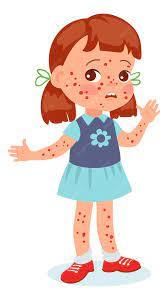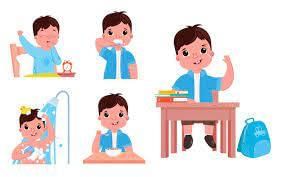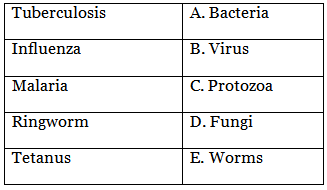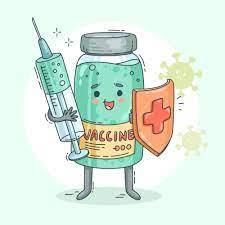Food, Nutrition, Health and Diseases - 2 Class 5 Worksheet Science
Q1: Fill in the blanks.
(i) The word "disease" stands for ________.
(ii) Diseases that do not pass from one person to another are called _________ diseases.
(iii) Germs that cause communicable diseases are also known as _______.
(iv) Diseases like chickenpox and measles spread through ________ contact.
(v) Hygiene may be defined as practices that ensure cleanliness and _______.
Q2: Match the column.
Match the communicable diseases with their respective disease-causing germs (pathogens).

Q3: True or False.
(i) Non-communicable diseases can be passed from one person to another. (True/False)
(ii) Germs that cause communicable diseases cannot be seen through a microscope. (True/False)
(iii) Hygiene practices are essential to prevent communicable diseases. (True/False)
(iv) Vaccination helps our body acquire immunity against certain diseases. (True/False)
(v) Houseflies and cockroaches can carry disease-causing germs on their bodies. (True/False)
Q4: Choose the odd one out.
(i) Measles, Mumps, Tetanus, Chickenpox
(ii) Virus, Bacteria, Protozoa, Snake
(iii) Influenza, Tuberculosis, Cholera, Malaria
(iv) Hygiene, Vaccination, Medication, Quarantine
(v) Direct Mode, Indirect Mode, Vectors, Non-communicable
Q5: Arrange in the correct order.
Arrange the following steps in the correct order to prevent communicable diseases.
A. Use a mosquito net or mosquito repellent at night.
B. Wash your hands before and after eating food and after going to the toilet with soap and water.
C. Wash fruits and vegetables well before cooking or eating them.
D. Drink clean water.
E. Do not allow heaps of garbage to collect near your home. Dustbins should be kept covered.
Q6: Define the following words.
(i) Non-communicable diseases
(ii) Hygiene
(iii) Vaccination
(iv) Communicable diseases
(v) Pathogens
The solutions of the worksheet "Food, Nutrition, Health & Diseases - 2"
|
42 videos|230 docs|45 tests
|
FAQs on Food, Nutrition, Health and Diseases - 2 Class 5 Worksheet Science
| 1. What are the health benefits of a balanced diet? |  |
| 2. How does nutrition affect our overall health? |  |
| 3. What are the common diseases caused by poor nutrition? |  |
| 4. How can we prevent nutritional deficiencies? |  |
| 5. How does food affect our mental health? |  |

















